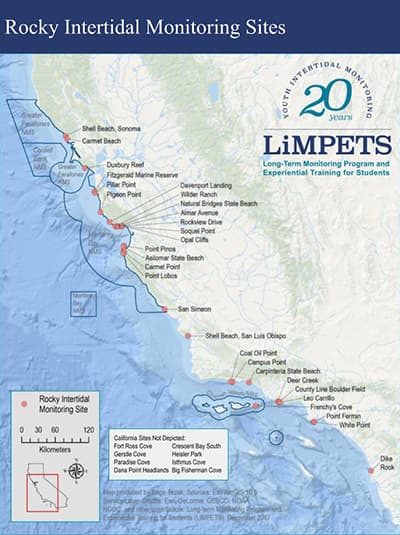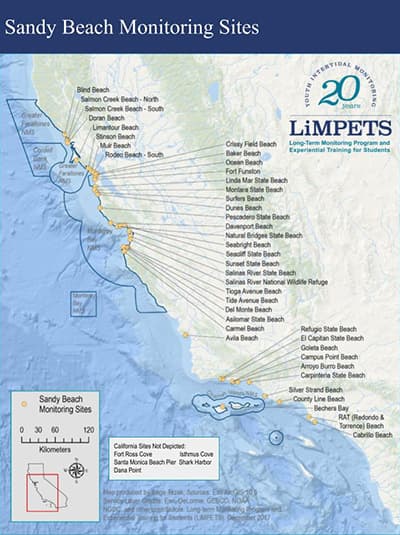Celebrating the National Marine Sanctuary System and LiMPETS anniversaries across California's national marine sanctuaries

2022 marks the 50th anniversary of the National Marine Sanctuary System and 20th anniversary of Long-term Monitoring Program and Experiential Training for Students (LiMPETS). In celebration of these two special anniversaries, California's national marine sanctuaries are engaging local communities in Eyes in Sanctuaries. Channel Islands, Monterey Bay, and Greater Farallones national marine sanctuaries – together with LiMPETS partners Greater Farallones Association, Pacific Grove Museum of Natural History, and University of Southern California Sea Grant – invite education networks, youth, families, and other members of the interested public to learn about and support citizen science monitoring of several rocky intertidal and sandy beach species this fall, including sea stars, mussels, and sand crabs.
Eyes in Sanctuaries Public Events

Date: November 9, 2022
Location: Carpinteria State Beach, 205 Palm Ave, Carpinteria, CA
Time: 11:00am to 1:00pm PT
Cost: Free
Contact: Sam Cook, samantha.cook@noaa.gov
Date: November 11, 2022
Location: Heal the Bay Aquarium, Santa Monica Beach (by the pier), 1600 Ocean Front Walk, Santa Monica, CA
Time: 9:30am to 11:00am PT
Cost: Free
Contact: Linda Chilton, lchilton@usc.edu
Volunteer Service Agreement for Eyes in Sanctuaries participants under the age of 18
Likeness and Profile Release for all Eyes in Sanctuaries participants
Share your Eyes in Sanctuaries experience on social media using #EyesinSanctuaries
LiMPETS Youth Intertidal Monitoring

The LiMPETS network is a youth-based citizen science program that annually connects over 6,000 educators, students, volunteers, and other community members to the ocean. LiMPETS offers direct involvement in real scientific endeavors to increase awareness of and interest in the marine environment. Program participants help support meaningful contributions to science, engage in real-world applications of STEM learning, and become stewards of their local ocean and coastal spaces.

Partnerships
Created in 2002, the LiMPETS network is a collaborative effort between Greater Farallones Association, Pacific Grove Museum of Natural History, University of Southern California Sea Grant, and California's national marine sanctuaries. The success of the LiMPETS network offers an exciting opportunity to highlight other sanctuary and partner stewardship activities in celebration of 50 years of ocean and coastal conservation.
Additional local volunteer and academic monitoring programs that have their Eyes in Sanctuaries include:
- MARINe (Multi-Agency Rocky Intertidal Network)
- PISCO (Partnership for the Interdisciplinary Studies of Coastal Oceans)
- NOAA's Phytoplankton Monitoring Network
- Monterey Bay National Marine Sanctuary Team OCEAN (Ocean Conservation Education Action Network)
- Bay Net
- BeachCOMBERS (Coastal Ocean Mammal and Bird Education and Research Surveys)
- Greater Farallones National Marine Sanctuary Beach Watch
- MPA Watch
Species Monitored
Sea Stars
Habitat: Rocky intertidal


Ochre sea stars (Pisaster ochraceus) in shades of yellowish-brown, purple, and orange are commonly seen intertidal predators. However, beginning as early as June 2013, sea stars along the Pacific began dying from what has become known as "sea star wasting syndrome." As part of an effort to assess recovery of the species, Eyes in Sanctuaries participants will learn how to search for and count sea stars at monitoring sites across the California coast.
Mussels
Habitat: Rocky intertidal


Clumps of California mussels (Mytilus californianus) crowd wave-swept rocks and are often the dominant space-occupier in the mid-intertidal zone. Mussel beds provide important refuge and habitat for a variety of invertebrates and algae. Yet increased poaching has resulted in negative impacts to the species and the benefits they provide. Through surveys, Eyes in Sanctuaries participants will help determine the coverage of mussel communities.
Sand Crabs
Habitat: Sandy beach


Pacific sand crabs (Emerita analoga) are an important food source for fishes and shorebirds. They can also tell us a lot about the sandy beach environment. For example, sand crabs' ability to accumulate toxins makes them a great indicator of water pollution. Sand crabs also depend on healthy beach characteristics like kelp wrack that provides habitat for the sand dwellers. Human impacts such as beach grooming mechanically remove kelp wrack which decreases the abundance of sand crabs and, ultimately, their fish and shorebird predators. Data collected during Eyes in Sanctuaries events and activities will help to inform sand crab monitoring efforts.
More Information
This project was funded in part by federal award NA19NOS4290190A with the National Marine Sanctuary Foundation.






